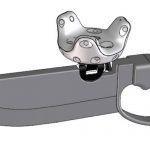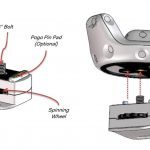Ahead of the Vive Tracker’s consumer launch later this year, HTC plans to send 1,000 units to developers to kickstart an ecosystem of accessories and content which can make use of the device. New developer documentation details the ins and outs of the Tracker.
Developers and accessory-makers looking to make use of the Vive Tracker can get a head start by perusing the HTC Vive Tracker Developer Guidelines document that has recently been made public. Inside, we learn more about the Tracker’s capabilities, including what kind of data can be sent wirelessly from the Tracker to the PC, and the existence of an additional dongle which is needed for the device to be tracked.
![]() An overview of the Vive Tracker reveals that the device’s power button is cleverly hidden as part of the central Vive logo, along with the rest of the device’s functions.
An overview of the Vive Tracker reveals that the device’s power button is cleverly hidden as part of the central Vive logo, along with the rest of the device’s functions.
Input/Output
We also learn more detail about what data the Tracker can send to the host PC through its Pogo pin and USB interfaces. Using the six Pogo pin connections on the bottom of the device, an attached accessory can emulate the same controls as a Vive controller, allowing the accessory to send data like trigger pulls and button presses (for things like shooting and reloading inside the game). Emulation of all inputs on the Vive controller appears to be supported, including sending X and Y coordinates to simulate the location of a user’s finger on the controller’s trackpad, and varying levels of trigger pull sensitivity. It appears too that the Tracker can receive and relay rumble commands from the computer which could be used to activate haptics on the third-party accessory.
It seems that arbitrary data beyond emulation of the Vive controller inputs can also be sent via the MicroUSB connection, which would open the door to more specialized usage.
Design Recommendations for Max Performance of Wireless Dongle
As we understand it, the Vive controllers today connect wirelessly to the Vive headset and then their data is sent to the computer via the headset’s tether, and vice versa. The Vive Tracker, it turns out, will not use the same system, but will rather rely on its own wireless dongle (USB 2.0) to relay its tracking data and accessory I/O.
In order to keep the dongle operating at maximum throughput and avoid tracking issues due to lost data, the Vive Tracker Developer Guidelines document says accessory makers should design their products in a way that avoids bringing any non-essential metal within 30mm of the Tracker’s antenna, seen highlighted in red above.
Field of View and Tracking Considerations
![]() The document specifies that the Tracker has a 270 degree field of view (for sensing the SteamVR Tracking basestations); the ‘bottom’ part of the device eschews sensors with the expectation that it will be mounted to something. In order to avoid blocking any additional field of view of the Tracker, it’s recommended that accessories protrude as little as possible outside of the device’s inherent blindspot.
The document specifies that the Tracker has a 270 degree field of view (for sensing the SteamVR Tracking basestations); the ‘bottom’ part of the device eschews sensors with the expectation that it will be mounted to something. In order to avoid blocking any additional field of view of the Tracker, it’s recommended that accessories protrude as little as possible outside of the device’s inherent blindspot.
Furthermore, the document specifies that accessories should be made with non-reflective material to maintain maximum tracking performance, presumably to avoid reflections from the tracking lasers which could confuse the device or even the Vive headset while in use.
Attaching the Tracker to Accessories Won’t Cause Harm (hopefully)
Thankfully, for all of us who plan on using these accessories, a section of the document specifies that, “the user should not be physically harmed while attaching or detaching the tracker. ” If this hadn’t been in there, who knows what harm might have come to us!
– – — – –
There’s plenty more gritty technical detail contained in the document. If you’re a developer, you may want to dig in further. If you’re not a developer, you’ll probably want to know that the Vive Tracker is due to launch in Q2 of 2017 and hasn’t yet been priced.








